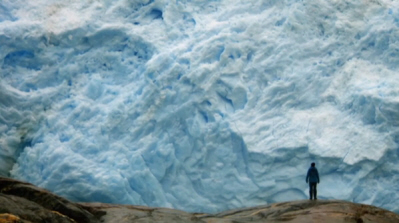Perihelion
The Closest Point to the Sun

Climate Cells
I'm starting in the Scottish Highlands on a particularly significant day in our journey around the sun.
It's the 3rd of January, it's -5 degrees and the Winds are gusting to over 60 km an hour. I'm walking up Aonach Mor. One of the highest mountains in Scotland. If it was a beautiful clear sunny day, you'd be able to see Ben Nevis and if I was going to be very British and stiff upper-lipped, I'd say it was a little bit chilly. One of the highest mountains in Scotland
So why one, might ask, am I going to the effort of climbing over 1000 m in these conditions? Well, by being here on Aonoch Mor, I'm about as close to the sun as I'll ever be and it's actually not because of where I am but when I'm making this climb. Today, we are physically closer to the sun than on any other day of the year. It's a day with a special name it's called calledd perihelion, and although it's impossible to believe, in conditions like this, the Earth is 5,000,000 km closer to the Sun today than it will be in July. At perihelion being on top of this mountain on this day, brings me one more: km closer to the sun. It may seem strange that on some days we can be much closer to the Sun than others, but it's a consequence of a particular feature of the Earth's orbit.
The Earth's journey through space is controlled by the sun's gravity. But it isn't quite the orbit you might expect. Instead, it's an ellipse. Not only is the sun's orbit elliptical, the sun isn't in the centre of it. That means that our distance from the sun varies continuously throughout the year. And today, on orbit generally the thought we are there-closer to the sun than we will be for the whole of the rest of the year.

Rugged Weather on Aonach Mor
The Earth's elliptical orbit means that in January, at perihelion, the Earth receives about 7% more solar energy than it does in July, When the Earth is at its furthest point from the sun. You might think that this extra energy would mean that January would be warm and July would be cold. Well, it turns out that proximity to the sun doesn't guarantee warmth.
The reason for this apparent anomaly is that there is a second, more powerful factor at work. As it orbits the sun, the Earth is tilted on its axis at angle on just over 23°. Because of this 23.4° tilt, in January, the northern hemisphere is pointing away from the sun. The Earth's tilt reduces the amount of solar radiation in the northern hemisphere by up to 50%, far more than perihelion increases it, which is why it's winter in Britain, even though this is when the at it's closest to the sun.

Glacier dwarfs Kate
But perihelion in the southern hemisphere coincides with summer, so in theory,, the relative proximity of the sun and the extra energy this brings should mean this part of the world has particularly hot summers. I've come to Chile to discover whether this holds true. This is Puerto Williams. It's not just the southernmost town in Chile, it's the southernmost town in the world. The next significant land mass from here is Antarctica. Puerto Williams is a good place for us to be because it's at an equivalent latitude to the UK. So we can find out how summers here, in the southern hemisphere, compare to ours.
I'm heading into stretch of water called the Beagle Channel that crosses the bottom of the continent. It's named after HMS Beagle the boat that carried Charles Darwin here almost 200 years ago. Truth be told, so far, conditions are not hugely different to summers back home. But there is a difference and it's something you'd never see in the UK. A glacier.
And what is so astonishing about this is its location. This isn't the only glacier in this region, not by a long way. And yet, we're at 55° latitude south. If you go to the equivalent latitude in the North, 55° North, you get to the Lake District in England. Now, we all know that the Lake District is very pretty. But it hasn't got one of those.
